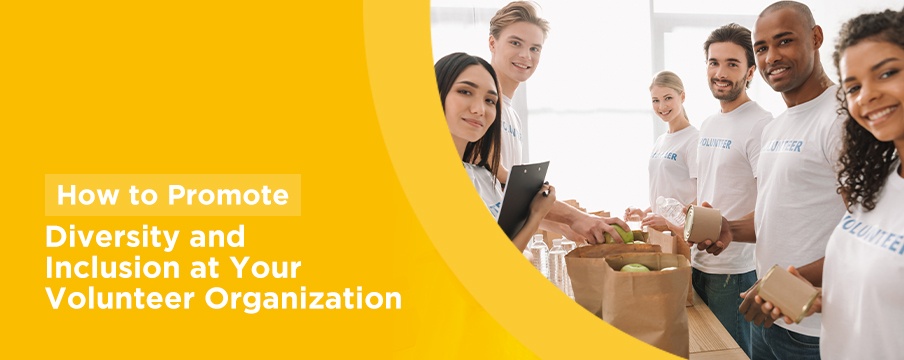Inclusion and diversity in volunteerism have become a hot topic for nonprofits lately. These organizations dedicate themselves to helping the community. Still, they struggle to find volunteers and even staff and leadership that represent the communities they serve. Let’s talk more about how to create a more inclusive volunteer program and why it’s so important.
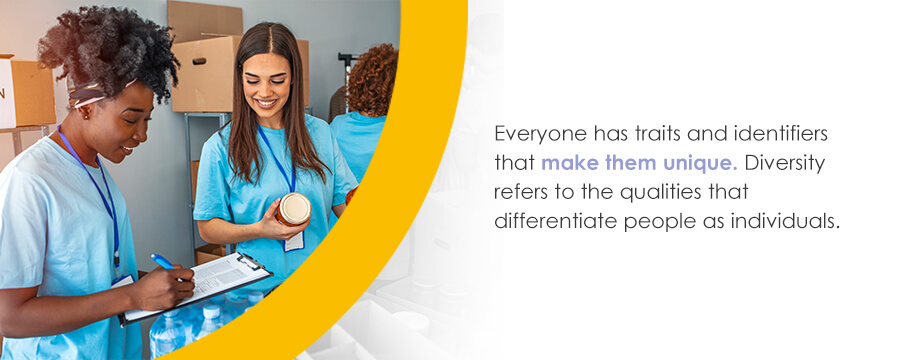
What Does Diversity Look Like in a Volunteer Organization?
Everyone has traits and identifiers that make them unique. Diversity refers to the qualities that differentiate people as individuals. Specifically, it is the condition of being composed of different elements. You can think of “variety” as a synonym for diversity. When it comes to organizational and social diversity, we’re usually concerned with the human traits that contribute to a diverse volunteer makeup. Many nonprofit organizations also extend their diversity efforts to their employees.
Diversity takes many forms and is limited only by the number of traits we use to define and identify people. An organization can have a diversity of:
- Race
- Socioeconomic status
- Gender
- Sexuality
- Individuals with disabilities
- Cultural interests
- Ages
- Marital status
- Work habits
- Educational backgrounds
- Religious beliefs
- Points of view
If a volunteer organization wants to achieve social diversity, they want to make sure their helpers and employees come from many backgrounds. In other words, the organization isn’t working exclusively with one type of person. Instead, they actively recruit among all walks of life. They seek to create a work environment that allows all kinds of volunteers to succeed and contribute meaningfully. Their volunteer team would then include people from all different backgrounds and with varying beliefs, values, and habits.
Inclusion is a separate concept that often goes hand-in-hand with diversity. For most volunteer organizations, inclusion goes beyond avoiding discrimination. Inclusion is about actively involving people and empowering them to be part of your organization. It recognizes inherent worth in all people, no matter their beliefs, ethnic background, talents, age, gender, and other unique traits. Inclusive philosophies and practices are often necessary for promoting diversity at nonprofits. Inclusion brings with it a sense of belonging for everyone.
Diversity and inclusion for volunteer organizations also incorporate variety in the roles available. Role variety is an essential element of diversity because different kinds of people are attracted to various jobs. Offering a diverse range of volunteering opportunities, such as high- and low-time commitment and roles requiring different skill sets, will attract a more diverse body of volunteers.
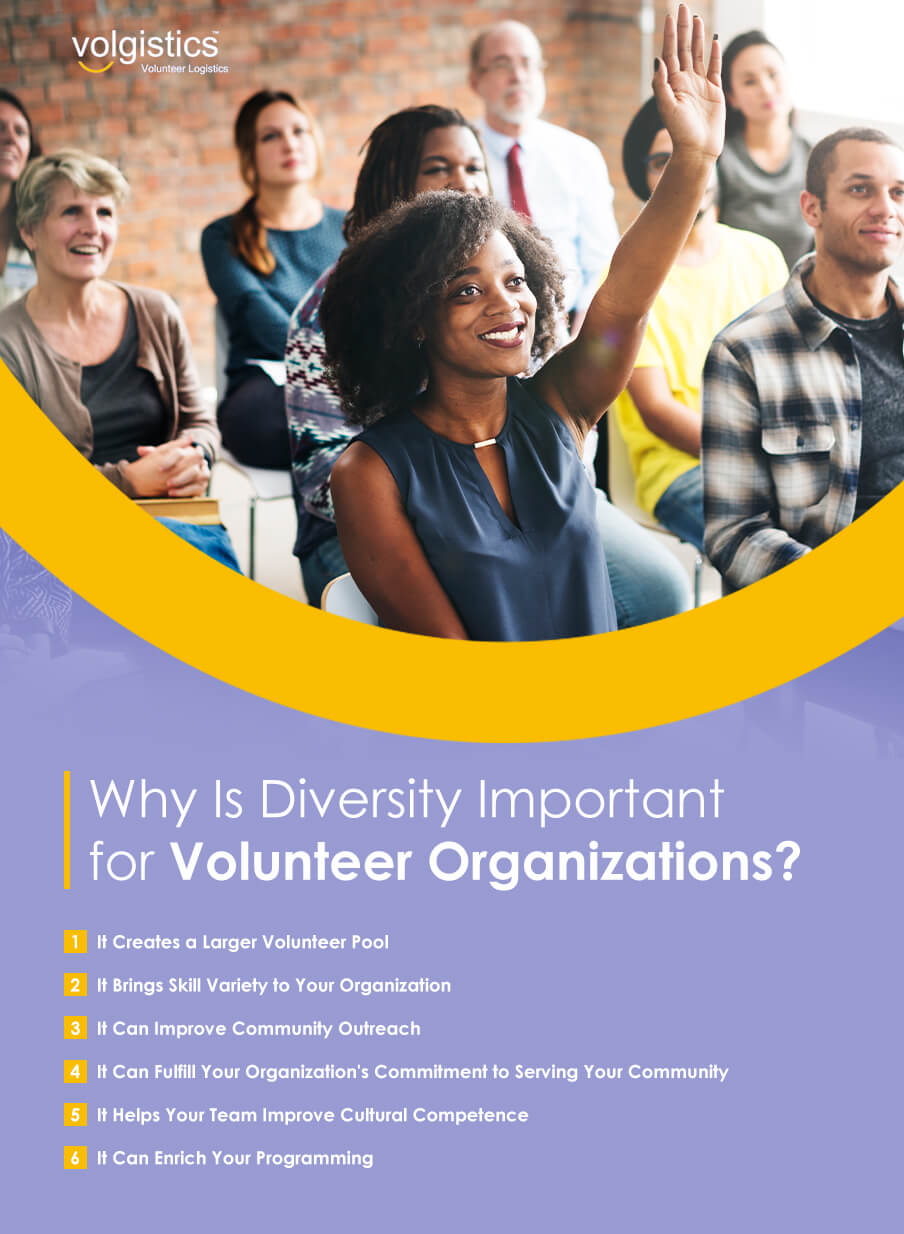
Why Is Diversity Important for Volunteer Organizations?
Every individual brings value to your organization. When you focus on diversity, you introduce new perspectives and experiences to your workforce. These differences make your team stronger. New skills and ideas can enter your organization and play off one another.
For many organizations, diversity and volunteerism go hand-in-hand. As a nonprofit dedicated to making the world a better place, you likely see an inherent value in creating opportunities for people from all walks of life. Working with diverse volunteers also helps your organization in many ways. How does inclusivity help nonprofits succeed? Diversity is good for volunteer organizations because:
1. Inclusivity Helps Grow Your Team of Volunteers
When your organization actively recruits from many communities, you increase your volunteer pool. When you remove the barriers that may hinder some people from volunteering, you can welcome more people into your ranks.
Your diverse volunteers can also act as role models to others with similar identities. People often feel more welcome at an organization when fellow members reflect their backgrounds or ideas. So, hiring diverse volunteers can invite more people to consider working with you. Diversity can then increase your volunteer pool even further.
By extension, a larger volunteer pool also creates a larger donor pool. First, many volunteers become donors and vice versa. Second, when potential donors recognize your commitment to diversity and inclusion in your volunteer organization, they may be more likely to give. And third, you could also be eligible for more grants that prioritize diversity at volunteer organizations.
2. Diversity Finds Unique Skill Sets From Volunteers
Diversity makes workplaces more effective. A gender-diverse executive suite is 15% more likely to have above-average profits. A racially and ethnically diverse workforce exhibits 35% better performance than other teams. When people from diverse backgrounds join together, they bring with them different life experiences and skills. People with different educational backgrounds and work experience will contribute differing hard skills. Some may be talented at marketing, while others can handle accounting or legal needs.
Meanwhile, people with different social, economic, and cultural backgrounds exhibit different soft skills. Some may excel in communication, especially communicating with diverse audiences, while others may have exceptional creativity or problem-solving skills. Still others may have excellent leadership skills. When your volunteer group is less homogenous, you have more chances to access unique skill sets.
3. It Connects Organizations with Communities They Serve
Some communities are less trustful of groups that don’t reflect their identities. When reaching out to different groups, it’s helpful to have allies who reflect those identities and experiences. Many groups could be more responsive to a diverse volunteer team. Team members with diverse backgrounds might better understand and respond to community needs.
Personal experience helps volunteers recognize community needs better than an outsider with limited first-hand knowledge. Some volunteers may speak another language, for instance, allowing them to communicate with constituents in their first language.
A study from the corporate world illustrates this point. According to Harvard Business Review, when a team member shares a client’s ethnicity, the whole team is 152% more likely to understand that client well. In the nonprofit sector, that ability to understand your constituents is crucial to delivering your services.
Diversity can also improve your public image. A diverse volunteer team lets your wider community see your commitment to inclusivity. Lawmakers and donors may hold a more favorable perception of your nonprofit, helping you get more done as an organization.
4. It Can Fulfill Your Organization’s Commitment to Serving Your Community
One of the most valuable benefits of diversity at nonprofits is the ability to help a diverse population. Whether you’re a local or national organization, you have a goal to serve your community. Truly serving your community means supporting the entire population. As the nation grows more diverse, a diverse volunteer workforce is inherently more representative of the people you serve.
Volunteering opportunities can also impart valuable skills to historically underprivileged groups. When you create these opportunities for people of all backgrounds, you can serve your community through your mission and your program. Volunteers can build their resumes and gain valuable career skills through their work.
5. It Helps Your Team Improve Cultural Competence
Cultural competency is crucial in any organization that serves people from different cultural backgrounds. Having volunteers from diverse cultures can improve awareness for your whole organization. When your volunteers and staff encounter people from different backgrounds from their own, they’ll be more equipped to understand each person’s needs and relate to them.
6. It Can Enrich Your Programming
New ideas and a fresh outlook improve your team in many ways. Companies with above-average workforce diversity earn 45% of their revenue from innovation. Companies with below-average diversity earn just 26% of their income this way. Diversity can also lead to better decision-making. One study from the Journal of Personality and Social Psychology found that racially diverse groups focus more on facts when making decisions. Ethnically diverse groups are also 58% more likely to price stocks correctly.
What do these numbers mean for a volunteer organization? A diverse volunteer force can improve innovation and decision-making. They bring together many perspectives and new ideas. Your programming, fundraisers, and other efforts will all be better off.
How Can You Promote a Culture of Diversity and Inclusion?
Many organizations see the value in a diverse volunteer base. They want to provide equal opportunities and reap the benefits of having volunteers that reflect the many communities they serve.
Fostering inclusion and diversity in volunteering might seem challenging initially. Any type of recruiting is tough for many organizations. It takes time to find good fits for your team who have the time and passion to dedicate. If your organization does not already have a robust group of volunteers from diverse backgrounds, adding this dimension to your recruiting process creates a more significant challenge.
Learn how to promote diversity in volunteer organizations with these 10 strategies:
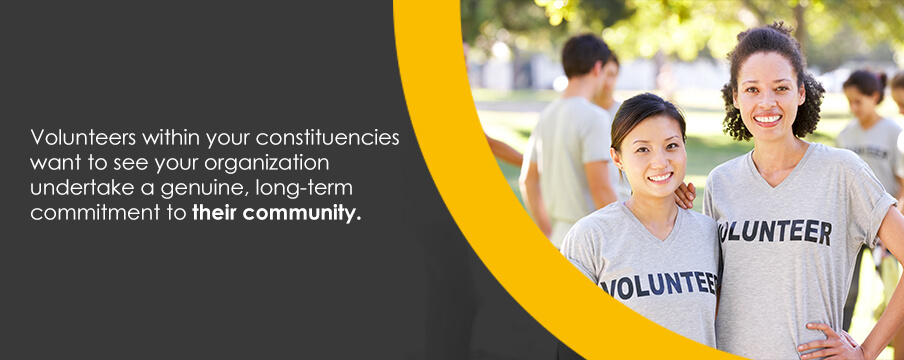
1. Expand Your Volunteer Recruitment Strategies
To find more diverse volunteers, it’s crucial to recruit in the right communities. Knowing how to recruit diverse volunteers in these communities requires careful outreach. Each community is unique and could have a distinct culture that’s unfamiliar to your team.
Developing relationships with diverse communities and their leaders is a crucial first step. Volunteers within your constituencies want to see your organization undertake a genuine, long-term commitment to their community. Volunteers don’t want to be recruited as a way to “check off a box” for diversity. They want to see their ideas taken seriously and the organization to put real effort into the relationship. Keep in mind that there’s no shortcut to building these connections.
The leaders within particular communities can also offer a window. Develop relationships with these leaders to make connections with potential volunteers. To build these connections, work with:
- Religious leaders
- Elected officials
- Small business owners
- Leaders of other cultural organizations
Manage your volunteer recruiting with Volgistics.
Register for your free demo to learn more.
Once you’ve developed strong relationships in the communities you wish to recruit, you can begin outreach. Ideally, one of your connections can invite you to give a presentation or recruit at an event. But dropping by for an informal chat can be effective, too. When you visit, have informational pamphlets you can leave with people. Some organizations to consider recruiting at include:
- Other nonprofits serving diverse communities
- Immigrant aid groups
- Places of worship
- Youth groups
- Sports organizations
- Volunteer centers
- Schools
- Unions or professional associations
- Arts and cultural groups and events
- Language classes
- Women- and minority-owned businesses
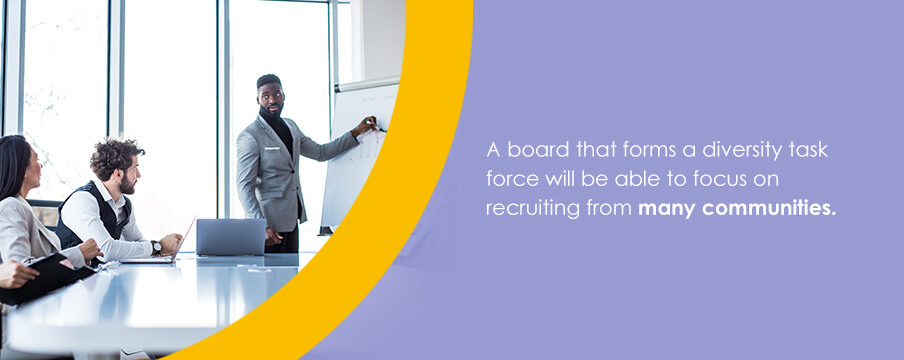
2. Engage the Board of Directors
Your board of directors has a massive influence on your organization. As leaders and often volunteers themselves, they can act as champions for your mission of diversity. An inclusive board will ensure a more diverse staff alongside its volunteers. A board that forms a diversity task force will be able to focus on recruiting from many communities. When your leadership treats diversity as a priority and is actively involved in developing a diverse volunteer group, you’re more likely to achieve your goals.
Developing a diversity plan specific to volunteering is crucial to achieving your inclusion goals. When you have a formal strategy in place, you improve diversity accountability at your nonprofit. Individuals at your organization will have specific duties and deadlines for developing a diverse volunteer base. Your board of directors can be integral to designing this plan and assigning roles.
Your board members might also have some of the connections you need to encourage diversity among volunteers. Board members are often involved and well-connected within their communities. They may serve on several nonprofit boards or as business and community leaders. If they aren’t leaders in the neighborhoods you wish to reach, they may have relationships with those who are. Here, they can act as your bridge builders. They might recruit helpers themselves. They could also set up meetings with community groups to help your organization connect with volunteers.

3. Focus on Volunteer Retention
Retaining volunteers can be a challenge for any organization. For one wanting to improve its volunteer diversity, retention can be even more challenging. If recruits don’t feel they belong in a homogenous organization, they may not want to return. If they don’t see diversity within an organization’s paid staff or leadership, they may feel there aren’t enough advancement opportunities. They may seek a position elsewhere, where they can find more benefits from their efforts. You must know how to get diverse volunteers engaged and excited about their roles.
Many general volunteer retention strategies can help you retain your diverse team. But the specific barriers to retention that affect your recruits from diverse backgrounds may require additional tactics. To retain a diverse group of volunteers, commit to diversity throughout your organization — not only on your volunteer workforce. When your team has representation, multicultural awareness, and an inclusive attitude, you’re more likely to create a safe and friendly work environment for volunteers from diverse backgrounds.
It’s also essential to provide meaningful mentorship to volunteers. Unpaid helpers are often looking to advance their careers and leadership skills. Those from diverse socioeconomic, racial, and ethnic backgrounds, alongside people with disabilities, may struggle to find these opportunities in for-profit environments. Thus, a robust volunteer mentorship program creates a mutually beneficial relationship through volunteering. Let helpers take ownership over their projects and become leaders within your group.
4. Consider a Diversity Leader
Like your board members, a dedicated diversity leader can help you better recruit a diverse base of volunteers. Many larger companies employ diversity officers whose job is to foster a diverse workforce and reach diverse customers. Your nonprofit can do the same.
When you have a board member or high-ranking staff member dedicated to recruiting and liaising with diverse volunteers, your organization will be more dedicated to its volunteer diversity. Larger nonprofits may be able to hire a full-time diversity officer. Smaller nonprofits might consider adding or appointing a board member specifically to handle organizational diversity.
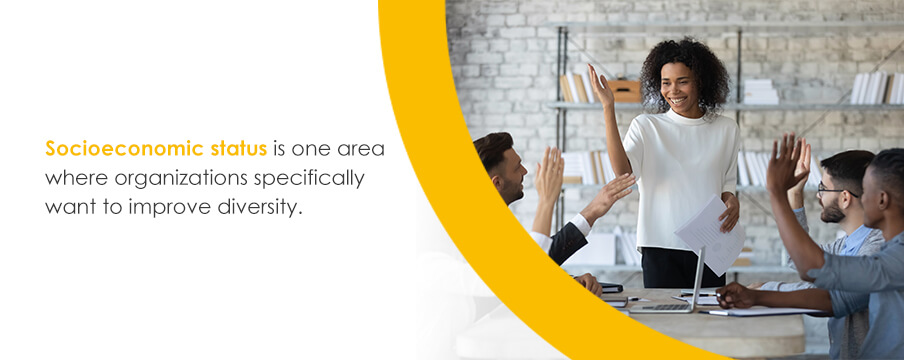
5. Stay Educated on the Diverse Impacts of Socioeconomic Status
Socioeconomic status is one area where organizations specifically want to improve diversity. Meanwhile, people with disabilities, racial and ethnic minorities, immigrants, women, and LGBTQ individuals have historically had less access to economic opportunity and higher-paying jobs. These factors can present an inherent barrier to volunteer opportunities. Those who struggle financially may not be able to volunteer for unpaid positions. Those who work several jobs to support themselves may not have the time to help.
When engaging low-income volunteers, a few steps can make volunteering more accessible and worthwhile. Consider providing:
- Child care: Free child care at volunteer events may allow working parents to participate. Even better, family-friendly events can involve kids of all ages and their parents.
- Transportation reimbursements: Providing stipends for volunteers’ related expenses can also help them access more volunteering opportunities. Consider providing bus or subway fare to make it easier for volunteers to get to the event or your headquarters. You might also organize ride-sharing and carpools among your team members for transportation.
- Free meals: Everyone appreciates food and snacks at a meeting or volunteer event. For those from low-income households, the food provided may be a strong motivator for volunteering. If you’re recruiting from a population with dietary restrictions, provide food that meets those needs.
- Outings: Many nonprofits give their volunteers tickets to sporting events, theater performances, or other events to say thank you. These perks are especially meaningful for helpers who couldn’t otherwise afford them.
6. Embrace Skill-Based Opportunities
Skills-based opportunities are volunteer tasks that companies would generally pay workers to perform. They’re crucial for nonprofits that cannot afford to hire full- or part-time employees for these tasks. These roles are particularly desirable to recent immigrants who aren’t yet cleared for work in the United States. Immigrants and convicted felons struggling to find employment can use skilled volunteer opportunities to build their resumes and demonstrate their abilities and work ethic to potential employers.
7. Recruit From Those That Use Your Services
In many cultures, the word “volunteer” doesn’t hold much meaning. But the concept of helping your neighbors and mutual support has incredible importance. For these communities, reciprocity may even be a requirement to providing the help you seek. It’s important to host events and provide services in the neighborhoods you want to recruit from. When you show a genuine commitment to serving a particular community, those with the means to help are more likely to offer it.
Those who benefit from your services are in a unique position to appreciate the value you provide. If you’ve helped someone, they may be excited to give back in any way they can.
Too many organizations don’t recruit from the communities they serve because it seems like they may be unable to volunteer their time. While that can certainly be true for some people, others are happy and able to help. Besides reciprocating the services you provide them, they may also be motivated to offer help to others in their community. The only way to know who can help is to ask.

8. Remove Barriers to Volunteering
Besides the socioeconomic barriers to volunteering, people from diverse populations and immigrants can face many other obstacles. Various groups also face different hurdles. For example, older adults may not have the physical ability for active volunteering roles. Single parents may struggle to find time to help. Some other barriers include:
- Background checks: Many background check services aren’t able to look at non-citizens. Sometimes, a background check is necessary to protect your staff, volunteers, and constituents. Consider if some roles don’t require background checks, or if there are alternative ways you can conduct background checks when they’re necessary.
- Other priorities: Someone with lower income, family priorities, or commitments to their wider community may struggle to meet rigid volunteer requirements. Consider loosening your rules about attendance and punctuality. Let helpers choose their schedules and level of time commitment.
- Organizational policies: Some organizations may have volunteer policies that inadvertently exclude specific populations. Do you require a minimum education level, a minimum time commitment, or some other rule that may hinder people from giving their time? To create a more inclusive and diverse volunteer program, your policies must let various people qualify to serve. Consider revising these policies to be inclusive of people from varying backgrounds and with different abilities.
- Lack of experience: While skills-based roles are attractive to some people, they may present barriers to others. Create worthwhile opportunities for varying skill levels. Consider skilled positions that also offer mentorship and training. These roles remove skills barriers and can even turn into a motivating factor for some volunteers.
9. Ensure Your Members Understand and Support the Message of Inclusion
Even if you have a diversity officer or another champion for the cause, volunteer diversity is everyone’s responsibility. Everyone at your organization, from fellow volunteers to staff, board members, and beyond, can make or break a volunteer’s experience. Anything from open hostility down to unknown blind spots can make someone feel unwelcome. Your entire organization must adopt an inclusive culture and a supportive attitude.
Successful diversity initiatives at nonprofits must go beyond volunteering. You must educate your whole team in diversity and inclusion for nonprofit organizations. During this training, provide examples of diversity at nonprofits that demonstrate its importance. Encourage a top-down approach where your board of directors is invested in and spearheads diversity. If you’re a volunteer manager, work to make your department more welcoming and inclusive. Train your volunteers in diversity and cultural awareness. Then, seek to expand your message of inclusion to the rest of your organization.
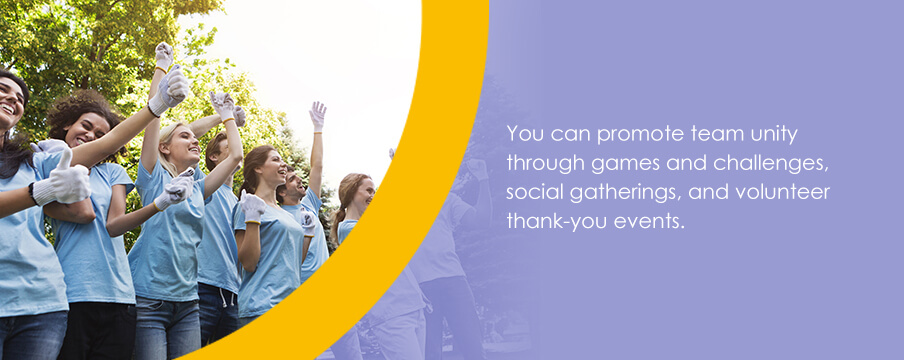
10. Incorporate Team Building
Encouraging diversity is a beautiful thing. Your organization stands to benefit from different cultures and viewpoints meshing together. But differences in beliefs, abilities, and socioeconomic status can create visible and invisible barriers within your organization. To avoid an “us vs. them” mentality, it’s crucial to build a cohesive, team-oriented community. You’re all united behind your mission to serve. Take advantage of that shared ideology to encourage team bonding.
You can promote team unity through games and challenges, social gatherings, and volunteer thank-you events. Volunteering is often considered a team-building experience in its own right. If you’re sensing aloofness or a lack of social interaction among your regular volunteers, consider hosting icebreaker meetings and activities to help volunteers get to know each other.

Manage a Diverse Team With The Help of Volgistics
At your volunteer organization, diversity and inclusion are keys to success. To achieve that diversity, you need an efficient volunteer management system that helps you manage helpers from all sorts of backgrounds.
The Volgistics volunteer management software makes recruiting and retaining your team that much easier. With an online opportunity directory and applications, any prospective volunteer can apply in just a few clicks. Meanwhile, your existing team members can use your volunteer portal to schedule themselves for unfilled hours and sign in for shifts. Using technology to make volunteering more convenient can make it easier to recruit and retain members from diverse backgrounds.
For volunteer managers, features like document storage, volunteer databases, reporting, and text and email capabilities make your job easier. Let your volunteer software do some of the work for you so you can focus on diversifying your volunteer base.
Check out Volgistics for yourself by signing up for your free 30-day trial or perusing a preloaded sample account.

